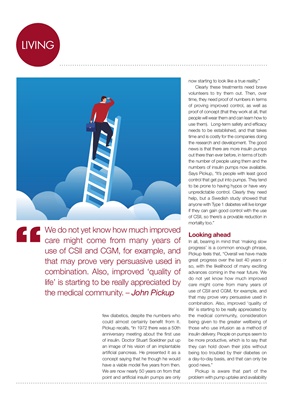
LIVINGLIVING
few diabetics, despite the numbers who
could almost certainly benefit from it.
Pickup recalls, "In 1972 there was a 50th
anniversary meeting about the first use
of insulin. Doctor Stuart Soeldner put up
an image of his vision of an implantable
artificial pancreas. He presented it as a
concept saying that he though he would
have a viable model five years from then.
We are now nearly 50 years on from that
point and artificial insulin pumps are only
"We do not yet know how much improved
care might come from many years of
use of CSII and CGM, for example, and
that may prove very persuasive used in
combination. Also, improved 'quality of
life' is starting to be really appreciated by
the medical community - Pickup
now starting to look like a true reality."
Clearly these treatments need brave
volunteers to try them out. Then, over
time, they need proof of numbers in terms
of proving improved control, as well as
proof of concept (that they work at all, that
people will wear them and can learn how to
use them). Long-term safety and efficacy
needs to be established, and that takes
time and is costly for the companies doing
the research and development. The good
news is that there are more insulin pumps
out there than ever before, in terms of both
the number of people using them and the
numbers of insulin pumps now available.
Says Pickup, "It's people with least good
control that get put into pumps. They tend
to be prone to having hypos or have very
unpredictable control. Clearly they need
help, but a Swedish study showed that
anyone with Type 1 diabetes will live longer
if they can gain good control with the use
of CSII, so there's a provable reduction in
mortality too."
Looking ahead
In all, bearing in mind that 'making slow
progress' is a common enough phrase,
Pickup feels that, "Overall we have made
great progress over the last 40 years or
so, with the likelihood of many exciting
advances coming in the near future. We
do not yet know how much improved
care might come from many years of
use of CSII and CGM, for example, and
that may prove very persuasive used in
combination. Also, improved 'quality of
life' is starting to be really appreciated by
the medical community, consideration
being given to the greater wellbeing of
those who use infusion as a method of
insulin delivery. People on pumps seem to
be more productive, which is to say that
they can hold down their jobs without
being too troubled by their diabetes on
a day-to-day basis, and that can only be
good news."
Pickup is aware that part of the
problem with pump uptake and availability